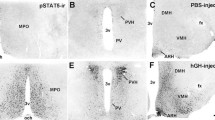Abstract
L-929 cells derive from a mouse connective tissue (Earle 1943). They secrete a neurotrophic factor which is immunologically and biochemically similar to the β-NGF found in mouse submaxillary glands (Oger et al. 1974; Brachet and Dicou 1984). Hybridizations with a β-NGF cDNA probe (Scott et al. 1983) have recently shown that L cells contain a β-NGF transcript identical in size to that produced by the submaxillary gland, and that the β-NGF locus of the genomic DNA is not rearranged, as evidenced by cleavage with some restriction enzymes (Wion et al. 1985). L cells, therefore, constitute a valuable model system suited for the study of the gene expression of the factor. The present work deals with a preliminary characterization of extracellular effector molecules which influence this expression. Extracellular concentrations of β-NGF were correlated with intracellular levels of the β-NGF mRNA in cells cultured in the presence or absence of serum, or exposed to testosterone, T3 or T4, which are known to enhance the β-NGF levels in the mouse submaxillary gland (Levi Montalcini and Angeletti 1968; Aloe and Levi Montalcini 1980).
Access this chapter
Tax calculation will be finalised at checkout
Purchases are for personal use only
Similar content being viewed by others
References
Aloe L, Levi Montalcini R (1980) Comparative studies on testosterone and L-thyroxine effects on the synthesis of NGF in the mouse submaxillary salivary glands. Exp Cell Res 125: 15–22
Brachet P, Dicou E (1984) L-cells potentiate the effect of the extracellular NGF activity in co-cultures with PC12 pheochromocytoma cells. Exp Cell Res 150: 234–241
Darmon M, Buc-Caron MH, Paulin D, Jacob F (1982) Control by the extracellular environment of differentiation pathways in 1003 embryonal carcinoma cells. EMBO J 1: 901–906
Earle WR (1943) Production of malignancy in vitro. The mouse fibroblast cultures and changes seen in the living cells. J Natl Cancer Inst 4: 165–212
Ebendal T, Olson L, Seiger A, Hedlung KO (1980) Nerve growth factors in the rat iris. Nature 286: 25–28
Furukawa S, Kamo I, Furukawa Y, Akazawa S, Satoyoshi F, Itok K, Kayashi K (1983) A highly sensitive enzyme immunoassay for mouse /3-NGF. J Neurochem 40: 734–743
Harper GP, Al-Saffar A, Pearce F, Vernon C (1980) The production of NGF in vitro by tissues of mouse, rat and embryonic chick. Dev Biol 77: 379–390
Korsching S, Thoenen H (1983) NGF in sympathetic ganglia and corresponding target organs of the rat: correlation with density of sympathetic innervation. Proc Natl Acad Sci USA 80: 3513–3516
Levi Montalcini R, Angeletti PU (1968) Nerve growth factor. Physiol Rev 48: 534–569
Oger J, Arnason B, Pantazis N, Lehrich J, Young M (1974) Synthesis of NGF by L and 3T3 cells in culture. Proc Natl Acad Sci USA 71: 1554–1558
Samuels HH, Stanley F, Casanova J (1979) Depletion of L-(3,5,3’) triiodothyronine and L-thyro- xine in euthyroid calf serum for use in cell culture studies of the action of thyroid hormone. Endocrinology 105: 80–85
Scott J, Selby M, Urdea M, Quiroga M, Bell G, Rutter W (1983) Isolation and nucleotide sequence of a cDNA encoding the precursor of mouse NGF. Nature 302: 538–540
Shelton P, Reichardt L (1984) Expression of the 0-NGF gene correlates with the density of sympathetic innervation in effector organs. Proc Natl Acad Sci USA 81: 7951–7955
Thomas P (1980) Hybridisation of denatured DNA and small DNA fragments transferred to nitro¬cellulose. Proc Natl Acad Sci USA 77: 5201–5205
Wion D, Barrand P, Dicou E, Brachet P (1985) Serum and thyroid hormones T3 and T4 regulate NGF mRNA levels in mouse L cells. FEBS Lett 189: 37–41
Author information
Authors and Affiliations
Editor information
Editors and Affiliations
Rights and permissions
Copyright information
© 1986 Springer-Verlag Berlin Heidelberg
About this paper
Cite this paper
Houlgatte, R., Wion, D., Barrand, P., Dicou, E., Brachet, P. (1986). Serum Influences β-NGF Gene Expression in Mouse L Cells. In: Montalcini, R.L., Calissano, P., Kandel, E.R., Maggi, A. (eds) Molecular Aspects of Neurobiology. Proceedings in Life Sciences. Springer, Berlin, Heidelberg. https://doi.org/10.1007/978-3-642-70690-5_8
Download citation
DOI: https://doi.org/10.1007/978-3-642-70690-5_8
Publisher Name: Springer, Berlin, Heidelberg
Print ISBN: 978-3-642-70692-9
Online ISBN: 978-3-642-70690-5
eBook Packages: Springer Book Archive




